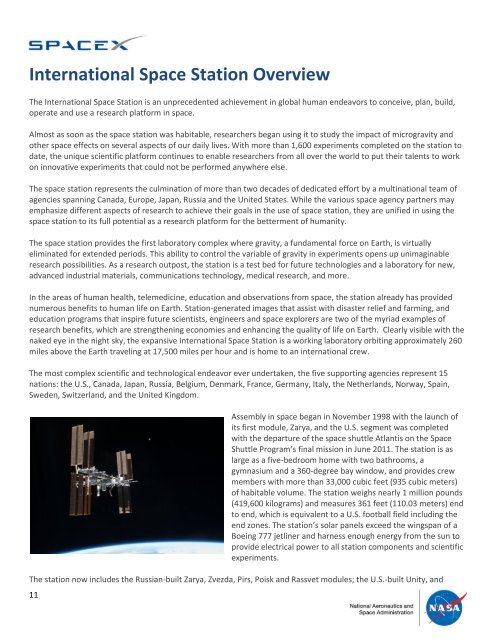spacex_nasa_crs-6_presskit
Create successful ePaper yourself
Turn your PDF publications into a flip-book with our unique Google optimized e-Paper software.
International Space Station Overview<br />
The International Space Station is an unprecedented achievement in global human endeavors to conceive, plan, build,<br />
operate and use a research platform in space.<br />
Almost as soon as the space station was habitable, researchers began using it to study the impact of microgravity and<br />
other space effects on several aspects of our daily lives. With more than 1,600 experiments completed on the station to<br />
date, the unique scientific platform continues to enable researchers from all over the world to put their talents to work<br />
on innovative experiments that could not be performed anywhere else.<br />
The space station represents the culmination of more than two decades of dedicated effort by a multinational team of<br />
agencies spanning Canada, Europe, Japan, Russia and the United States. While the various space agency partners may<br />
emphasize different aspects of research to achieve their goals in the use of space station, they are unified in using the<br />
space station to its full potential as a research platform for the betterment of humanity.<br />
The space station provides the first laboratory complex where gravity, a fundamental force on Earth, is virtually<br />
eliminated for extended periods. This ability to control the variable of gravity in experiments opens up unimaginable<br />
research possibilities. As a research outpost, the station is a test bed for future technologies and a laboratory for new,<br />
advanced industrial materials, communications technology, medical research, and more.<br />
In the areas of human health, telemedicine, education and observations from space, the station already has provided<br />
numerous benefits to human life on Earth. Station-generated images that assist with disaster relief and farming, and<br />
education programs that inspire future scientists, engineers and space explorers are two of the myriad examples of<br />
research benefits, which are strengthening economies and enhancing the quality of life on Earth. Clearly visible with the<br />
naked eye in the night sky, the expansive International Space Station is a working laboratory orbiting approximately 260<br />
miles above the Earth traveling at 17,500 miles per hour and is home to an international crew.<br />
The most complex scientific and technological endeavor ever undertaken, the five supporting agencies represent 15<br />
nations: the U.S., Canada, Japan, Russia, Belgium, Denmark, France, Germany, Italy, the Netherlands, Norway, Spain,<br />
Sweden, Switzerland, and the United Kingdom.<br />
11<br />
Assembly in space began in November 1998 with the launch of<br />
its first module, Zarya, and the U.S. segment was completed<br />
with the departure of the space shuttle Atlantis on the Space<br />
Shuttle Program’s final mission in June 2011. The station is as<br />
large as a five-bedroom home with two bathrooms, a<br />
gymnasium and a 360-degree bay window, and provides crew<br />
members with more than 33,000 cubic feet (935 cubic meters)<br />
of habitable volume. The station weighs nearly 1 million pounds<br />
(419,600 kilograms) and measures 361 feet (110.03 meters) end<br />
to end, which is equivalent to a U.S. football field including the<br />
end zones. The station’s solar panels exceed the wingspan of a<br />
Boeing 777 jetliner and harness enough energy from the sun to<br />
provide electrical power to all station components and scientific<br />
experiments.<br />
The station now includes the Russian-built Zarya, Zvezda, Pirs, Poisk and Rassvet modules; the U.S.-built Unity, and


